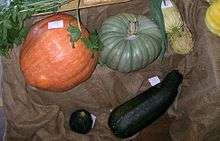Cucurbitaceae
| Cucurbitaceae | |
|---|---|
 | |
| Hodgsonia male plant | |
| Scientific classification | |
| Kingdom: | Plantae |
| (unranked): | Angiosperms |
| (unranked): | Eudicots |
| (unranked): | Rosids |
| Order: | Cucurbitales |
| Family: | Cucurbitaceae Juss.[1] |
The Cucurbitaceae, also called cucurbits and the gourd family, are a plant family consisting of ca 965 species in around 95 genera,[2] the most important of which are:
- Cucurbita – squash, pumpkin, zucchini, some gourds
- Lagenaria – mostly inedible gourds
- Citrullus – watermelon (C. lanatus, C. colocynthis) and others
- Cucumis – cucumber (C. sativus), various melons
- Luffa – the common name is also luffa, sometimes spelled loofah (when fully ripened, two species of this fibrous fruit are the source of the loofah scrubbing sponge)
The plants in this family are grown around the tropics and in temperate areas, where those with edible fruits were among the earliest cultivated plants both in the Old and New Worlds. The Cucurbitaceae family ranks among the highest of plant families for number and percentage of species used as human food.[3]

The Cucurbitaceae consist of 98 proposed genera with 975 species,[4] mainly in regions tropical and subtropical. All species are sensitive to frost. Most of the plants in this family are annual vines, but some are woody lianas, thorny shrubs, or trees (Dendrosicyos). Many species have large, yellow or white flowers. The stems are hairy and pentangular. Tendrils are present at 90° to the leaf petioles at nodes. Leaves are exstipulate alternate simple palmately lobed or palmately compound. The flowers are unisexual, with male and female flowers on different plants (dioecious) or on the same plant (monoecious). The female flowers have inferior ovaries. The fruit is often a kind of modified berry called a pepo.
Fossil history
One of the oldest fossil records so far is Cucurbitaciphyllum lobatum from the Paleocene epoch, found at Shirley Canal, Montana. It was described for the first time in 1924 by Knowlton. The fossil leaf is palmate, trilobed with rounded lobal sinuses and an entire or serrate margin. It has a leaf pattern similar to the members of the genera Kedrotis, Melothria and Zehneria.[5]
Classification
.jpg)
_Madrid_Botanico.jpg)
The following is a classification given by Charles Jeffrey in 1990. However, a 2011 study based on genetics does not support this taxonomy with two subfamilies and eight tribes, but rather delineates 15 tribes, five of them new, consisting of 95 genera rather than Jeffrey's 121.[6]
Subfamily Zanonioideae (small striate pollen grains)
- Tribe Zanonieae
- Subtribe Fevilleinae: Fevillea
- Subtribe Zanoniinae: Alsomitra Zanonia Siolmatra Gerrardanthus Zygosicyos Xerosicyos Neoalsomitra
- Subtribe Gomphogyninae: Hemsleya Gomphogyne Gynostemma
- Subtribe Actinostemmatinae: Bolbostemma Actinostemma
- Subtribe Sicydiinae: Sicydium Chalema Pteropepon Pseudosicydium Cyclantheropsis
Subfamily Cucurbitoideae (styles united into a single column)
- Tribe Melothrieae
- Subtribe Dendrosicyinae: Kedrostis Dendrosicyos Corallocarpus Ibervillea Tumamoca Halosicyos Ceratosanthes Doyerea Trochomeriopsis Seyrigia Dieterlea Cucurbitella Apodanthera Guraniopsis Melothrianthus Wilbrandia
- Subtribe Guraniinae: Helmontia Psiguria Gurania
- Subtribe Cucumerinae: Melancium Cucumeropsis Posadaea Melothria Muellarargia Zehneria Cucumis (including: Mukia, Dicaelospermum, Cucumella, Oreosyce, and Myrmecosicyos [7]).
- Subtribe Trochomeriinae: Solena Trochomeria Dactyliandra Ctenolepis
- Tribe Schizopeponeae: Schizopepon
- Tribe Joliffieae
- Tribe Trichosantheae
- Subtribe Hodgsoniinae: Hodgsonia
- Subtribe Ampelosicyinae: Ampelosicyos Peponium
- Subtribe Trichosanthinae: Gymnopetalum Trichosanthes Tricyclandra
- Subtribe Herpetosperminae: Cephalopentandra Biswarea Herpetospermum Edgaria
- Tribe Benincaseae
- Subtribe Benincasinae: Cogniauxia Ruthalicia Lagenaria Benincasa Praecitrullus Citrullus Acanthosicyos Eureiandra Bambekea Nothoalsomitra Coccinia Diplocyclos Raphidiocystis Lemurosicyos Zombitsia Ecballium Bryonia
- Subtribe Luffinae: Luffa
- Tribe Cucurbiteae (pantoporate, spiny pollen): Cucurbita Sicana Tecunumania Calycophysum Peponopsis Anacaona Polyclathra Schizocarpum Penelopeia Cionosicyos Cayaponia Selysia Abobra
- Tribe Sicyeae (trichomatous nectary, four- to 10-colporate pollen grains)
- Subtribe Cyclantherinae: Hanburia Echinopepon Marah Echinocystis Vaseyanthus Brandegea Apatzingania Cremastopus Elateriopsis Pseudocyclanthera Cyclanthera Rytidostylis
- Subtribe Sicyinae: Sicyos Sicyosperma Parasicyos Microsechium Sechium Sechiopsis Pterosicyos
- incertae sedis: Odosicyos
Alphabetical list of genera: Abobra Acanthosicyos Actinostemma Alsomitra Ampelosycios Anacaona Apatzingania Apodanthera Bambekea Benincasa Biswarea Bolbostemma Brandegea Bryonia Calycophysum Cayaponia Cephalopentandra Ceratosanthes Chalema Cionosicyos Citrullus Coccinia Cogniauxia Corallocarpus Cremastopus Ctenolepis Cucumella Cucumeropsis Cucumis Cucurbita Cucurbitella Cyclanthera Dactyliandra Dendrosicyos Dicaelospermum Dieterlea Diplocyclos Doyerea Ecballium Echinocystis Echinopepon Edgaria Elateriopsis Eureiandra Fevillea Gerrardanthus Gomphogyne Gurania Guraniopsis Gymnopetalum Gynostemma Halosicyos Hanburia Helmontia Hemsleya Herpetospermum Hodgsonia Ibervillea Indofevillea Kedrostis Lagenaria Lemurosicyos Luffa Marah Melancium Melothria Melothrianthus Microsechium Momordica Muellerargia Mukia Myrmecosicyos Neoalsomitra Nothoalsomitra Odosicyos Oreosyce Parasicyos Penelopeia Peponium Peponopsis Polyclathra Posadaea Praecitrullus Pseudocyclanthera Pseudosicydium Psiguria Pteropepon Pterosicyos Raphidiocystis Ruthalicia Rytidostylis Schizocarpum Schizopepon Sechiopsis Sechium Selysia Seyrigia Sicana Sicydium Sicyos Sicyosperma Siolmatra Siraitia Solena Tecunumania Telfairia Thladiantha Trichosanthes Tricyclandra Trochomeria Trochomeriopsis Tumacoca Vaseyanthus Wilbrandia Xerosicyos Zanonia Zehneria Zombitsia Zygosicyos[8]

Images of cucurbits in Byzantine mosaics from Israel
Six cucurbit crops are represented in 23 Byzantine-era mosaics from Israel, these being round melons (Cucumis melo), watermelons (Citrullus lanatus), sponge gourds (Luffa aegyptiaca), snake melons (faqqous, Cucumis melo Flexuosus Group), adzhur melons (Cucumis melo Adzhur Group), and bottle gourds (Lagenaria siceraria). Cucurbits are represented in 23 of the 134 mosaics containing images of crop plants, a surprisingly high frequency of 17%. Several of the cucurbit images have not been found elsewhere, suggesting a diverse and highly developed local horticulture of cucurbits in Israel during the Byzantine era. Representations of mature sponge gourds are found in widespread localities, suggestive of the high value accorded to cleanliness and hygiene.
Etymology and pronunciation
The name "Cucurbitaceae" (English /kjuːˌkʌrbᵻˈteɪsi, -siˌaɪ, -siˌeɪ, -siˌi/) comes to international scientific vocabulary from New Latin, from Cucurbita, the type genus, + -aceae,[9] a standardized suffix for plant family names in modern taxonomy. The genus name comes from the Classical Latin word cucurbita, "gourd".
References
- ↑ Angiosperm Phylogeny Group (2009). "An update of the Angiosperm Phylogeny Group classification for the orders and families of flowering plants: APG III" (PDF). Botanical Journal of the Linnean Society. 161 (2): 105–121. doi:10.1111/j.1095-8339.2009.00996.x. Retrieved 2013-07-06.
- ↑ Christenhusz, M. J. M. & Byng, J. W. (2016). "The number of known plants species in the world and its annual increase". Phytotaxa. Magnolia Press. 261 (3): 201–217. doi:10.11646/phytotaxa.261.3.1.
- ↑ "Cucurbits". Purdue University. Retrieved August 26, 2013.
- ↑ "Angiosperm Phylogeny Website". mobot.org.
- ↑ Revisions to Roland Brown's North American Paleocene Flora by Steven R. Manchester at Florida Museum of Natural History, University of Florida, Gainesville, Florida, USA. Published in Acta Musei Nationalis Pragae, Series B - Historia Naturalis, vol. 70, 2014, no. 3-4, pp. 153-210.
- ↑ Schaefer, Hanno; Renner, Susanne S. (February 2011). "Phylogenetic Relationships in the Order Cucurbitales and a New Classification of the Gourd Family (Cucurbitaceae)" (PDF). Taxon. 60 (1): 122–138. Retrieved 2 May 2011.
- ↑ Renner, S. S., Schaefer, H. & Kocyan, A.; Schaefer, H; Kocyan, A (2007). "Phylogenetics of Cucumis (Cucurbitaceae): Cucumber (C. sativus) belongs in an Asian/Australian clade far from melon (C. melo)". BMC Evolutionary Biology. 7: 58–69. doi:10.1186/1471-2148-7-58. PMC 3225884
 . PMID 17425784.
. PMID 17425784. - ↑ Ref: Watson and Dallwitz 3 September 2002
- ↑ Merriam-Webster, Merriam-Webster's Unabridged Dictionary, Merriam-Webster.
- David Bates, Richard Robinson, Charles Jeffrey, eds. (1990). Biology and Utilization of the Cucurbitaceae. Cornell UP. ISBN 0-8014-1670-1.
- Jeffrey, C. 2005. A new system of Cucurbitaceae. Bot. Zhurn 90: 332–335.
External links
| Wikimedia Commons has media related to Cucurbitaceae. |
| Wikispecies has information related to: Cucurbitaceae |
- Cucurbitaceae in T.C. Andres (1995 onwards).
- Cucurbitaceae in L. Watson and M.J. Dallwitz (1992 onwards). The families of flowering plants: descriptions, illustrations, identification, information retrieval. https://web.archive.org/web/20070103200438/http://delta-intkey.com:80/
- Anat Avital and Harry S. Paris, 2014, 'Cucurbits depicted in Byzantine mosaics from Israel, 350–600 CE', Annals of Botany 114: pp. 203-22.